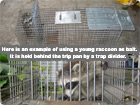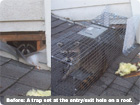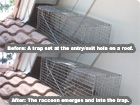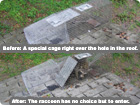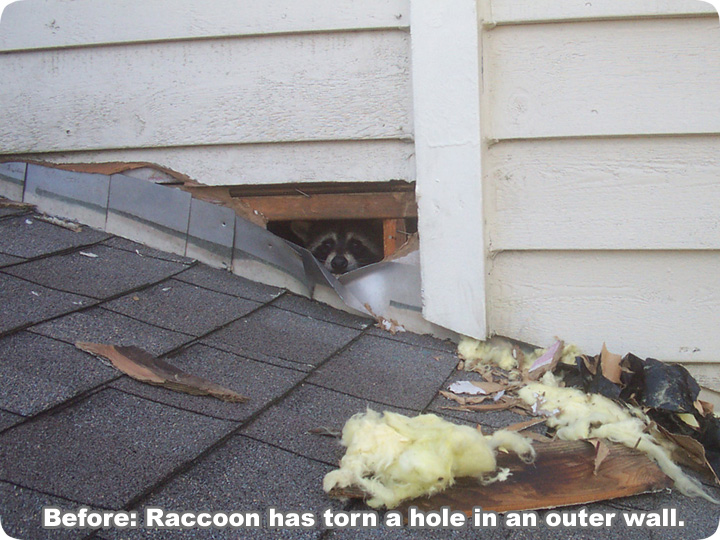
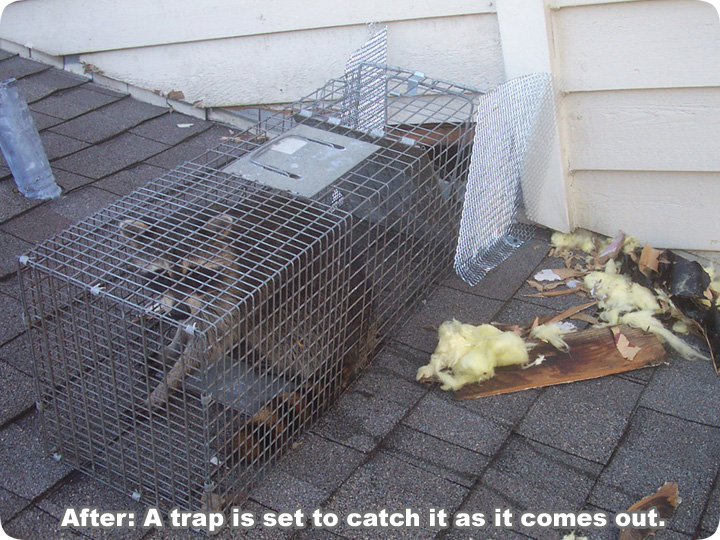
Click the buttons to the left or right for more examples of how the pros set traps in different situations.
In the above photos, a raccoon has ripped a hole right in the side of a wall next to the roof. I set a trap right at the hole, with no way for the raccoon to get out except to go in the trap.
If you need professional help, click my Hire A Pro page. I've compiled the USA's best directory of raccoon removal experts.
Where are raccoons getting into my house - A raccoon is a fairly sizeable pest animal and will therefore have sizeable entry holes. If you have walked around the base of your home and discovered nothing, it’s time to get out your ladder and inspect the top portion of your home. Just because there are no trees or poles next to your home doesn’t mean the raccoon can’t climb up to the roof. These mammals are amazing climbers, and they can often scale the side of a building without any assistance. The favorite points of entry near your roof will be where the building materials are weakest. A critter will look for damaged soffits, eaves, and vents. If the raccoon find a weak spot, it won’t hesitate to rip it open further. You usually can’t miss a raccoon hole, though it is possible for them to be entering the home through a hole you think belongs there. A good example of this is an unused chimney. Many older homes have forgone the use of fireplaces, leaving old chimneys sticking out of rooftops. If left uncapped, a raccoon can easily slink down the chimney and enter the home through deteriorated brick openings.
This is a series of photos of trap sets in the field. These examples are meant to show how professional trap setting looks. The reality is that every case of raccoon trapping is different: number of raccoons, location, type of architecture of the roof or attic they are in, etc. I've done over 1000 raccoon trapping jobs, and every set has been different. There are so many little variables that mean the difference between success and big problems! Trapping is not for amateurs.
If you need professional help, click my Hire A Pro page. I've compiled the USA's best directory of raccoon removal experts.
Where are raccoons getting into my house - A raccoon is a fairly sizeable pest animal and will therefore have sizeable entry holes. If you have walked around the base of your home and discovered nothing, it’s time to get out your ladder and inspect the top portion of your home. Just because there are no trees or poles next to your home doesn’t mean the raccoon can’t climb up to the roof. These mammals are amazing climbers, and they can often scale the side of a building without any assistance. The favorite points of entry near your roof will be where the building materials are weakest. A critter will look for damaged soffits, eaves, and vents. If the raccoon find a weak spot, it won’t hesitate to rip it open further. You usually can’t miss a raccoon hole, though it is possible for them to be entering the home through a hole you think belongs there. A good example of this is an unused chimney. Many older homes have forgone the use of fireplaces, leaving old chimneys sticking out of rooftops. If left uncapped, a raccoon can easily slink down the chimney and enter the home through deteriorated brick openings.
Click below photos for more examples of trap sets by professionals:
This is a series of photos of trap sets in the field. These examples are meant to show how professional trap setting looks. The reality is that every case of raccoon trapping is different: number of raccoons, location, type of architecture of the roof or attic they are in, etc. I've done over 1000 raccoon trapping jobs, and every set has been different. There are so many little variables that mean the difference between success and big problems! Trapping is not for amateurs.


